What type of reptiles do you fit in a 10-gallon-long tank?
You have a 10-gallon-long tank at home, wondering what reptiles can you fit in that 10-gallon long tank?
Well here are Nine reptiles that could do well in a ten-gallon tank. To help you further plan your trip to owning one of these amazing animals, we will go into detail about these reptiles, describe what they require in their surroundings, and provide you with options for tank design. The dimensions of a typical 10-gallon-long tank are approximately 20 inches long, 10 inches wide, and 12 inches high (height). When your pet becomes older and larger, it would be good to invest in a larger tank, even though many of these animals would thrive with a tank this size. This sort of setup is the absolute least (depending on the species).
Geckos, such as a house, leopard, and crested geckos, as well as sand boas, day geckos from Madagascar, rosy boas, pygmy chameleons, anoles, and African house snakes, are some of the best reptiles you can acquire for a 10-gallon long tank.
These species may live happily in a 10-gallon-long tank as long as you are careful to maintain and care for the ecology.
10 reptiles that fit just right in a 10-gallon-long tank.
So let’s get to the reptiles that are ideal for small tanks—what that’s what you came here for.
House geckos
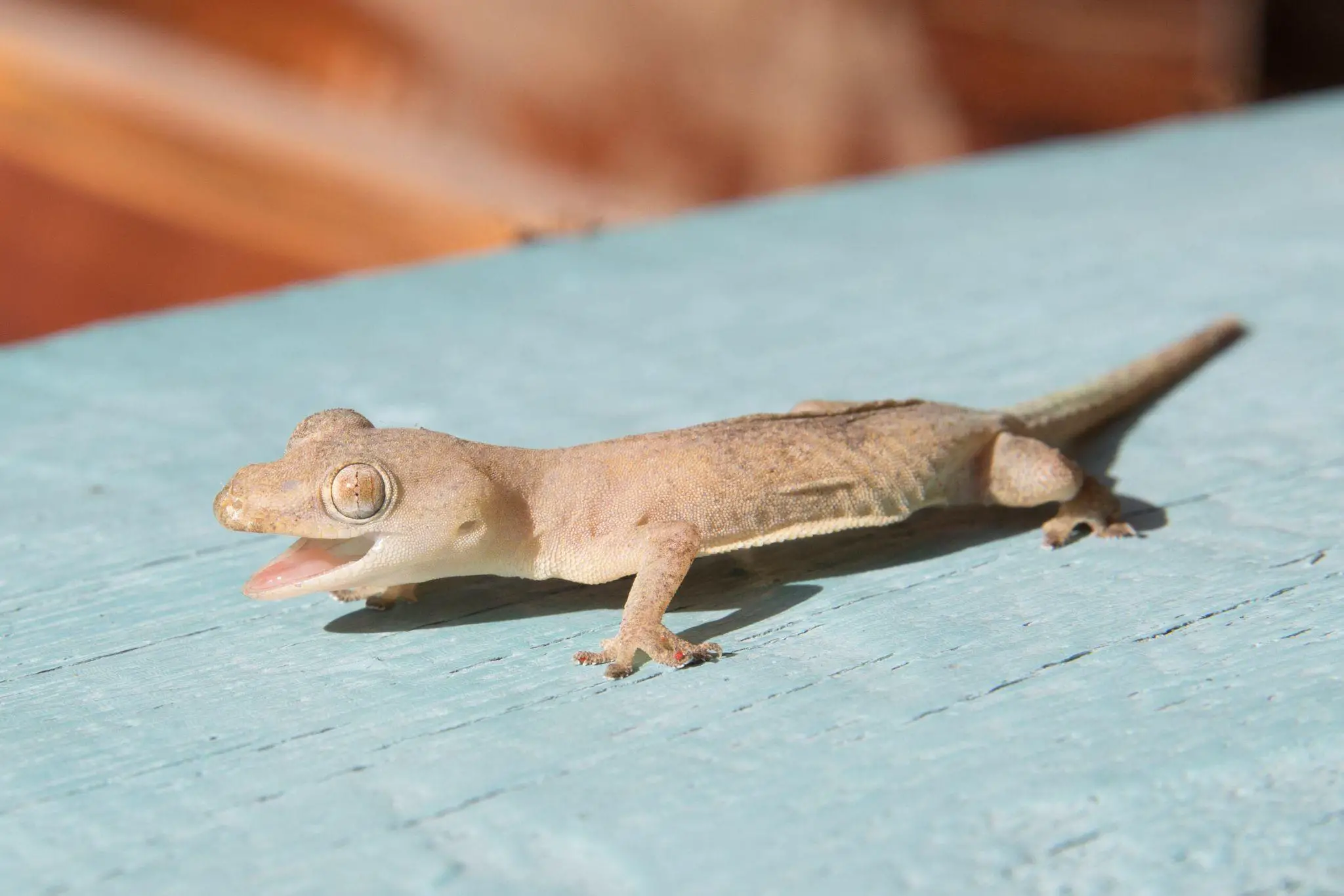
Image credits: wikipedia
These little geckos are also known as wall geckos and Turkish geckos. Given that they are just 5 inches long when the tail is taken into consideration, they are the ideal size for little 10-gallon aquariums.
These geckos require hiding places even when maintained alone in their vivariums, such as coconut shells turned on their sides or even a clay pot turned on its side. As they can both keep moisture, coconut fiber and reptile bark are both good alternatives for the substrate.
You shouldn’t use sand or reptile carpet since they can’t give your pet a humid atmosphere. Replace the contaminated substrate with fresh bark or fiber, if necessary.
Temperature gradients during the day should be between 75 and 90°F, whereas at night they should be between 65 and 75°F. Reptile bulbs and ceramic heat sources are ideal for creating such temperatures, as was previously mentioned.
Geckos are the nocturnal animals in question. Because of this, special UVB lighting is not required; yet, letting your gecko enjoy that UVB light might benefit their general health.
Humidity levels between 60 and 75 percent are necessary for geckos. To measure this accurately, make sure you have a hygrometer, and keep it where your gecko needs it.
Fruit flies, crickets, and even mealworms are preferred food items for house geckos. For optimal health, your gecko requires calcium and multivitamin supplements.
Leopard gecko
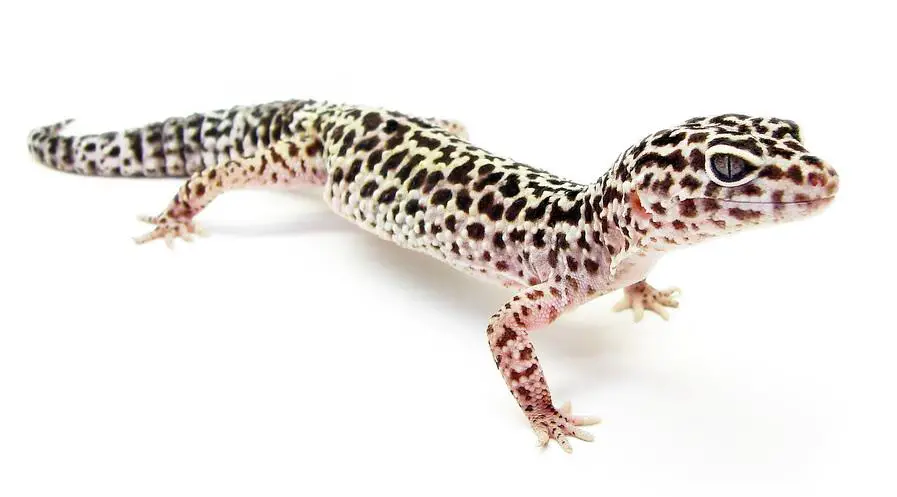
Image credits: wikipedia
The standard length is between 7 and 10 inches (at maturity).
Animals kept in captivity often live for 10 to 20 years.
Leopard geckos make wonderful pets, especially for beginners. These tiny lizards are indigenous to India, Nepal, Afghanistan, Iran, and Pakistan. They live in grasslands that resemble the desert in that they are stony and dry. They are low-maintenance pets for new pet owners because of their resilience.
They don’t need a lot of extra space in your 10-gallon-long tank because they spend a lot of time sitting. Leopard geckos frequently use shelters, so make sure you have adequate space for one.
The semi-desert reptiles known as leopard geckos like hot, dry climates. Leopard geckos like daytime temperatures of 75° to 85°F (24–29 °C), with heat lamps reaching up to 90°F (32 °C). Never allow the overnight temperature to go below 65°F (18°C). The optimal humidity range is between 30% and 40%.
The leopard geckos enclosures’ humidity and temperature shouldn’t be uniform. In order to generate a temperature gradient, the terrarium has to have a warm side (a “basking area” heated directly with daylight, a heat lamp, and/or a heat mat) and a cold side. Consequently, this tendency will cause humidity levels to be lower in hotter areas and greater in cooler areas.
Think about this Every day, your leopard gecko will run and stroll over the tank’s substrate, use it as a food source, urinate on it, try to burrow into it, and maybe even lay eggs in it. This makes substrate selection extremely important.
stone slate Stone slates are a great grip since they are naturally made to be attractive and are natural for less, but they may be challenging to get and erect.
paper towel This ugly substrate is often used by breeders of leopard geckos since it is both very safe and very practical.
clay excavation You can make your burrows and rock formations with hardened excavator clay, and it very roughly simulates the earth where your geckos would usually dwell. intriguing content
Kenyan sand boa.
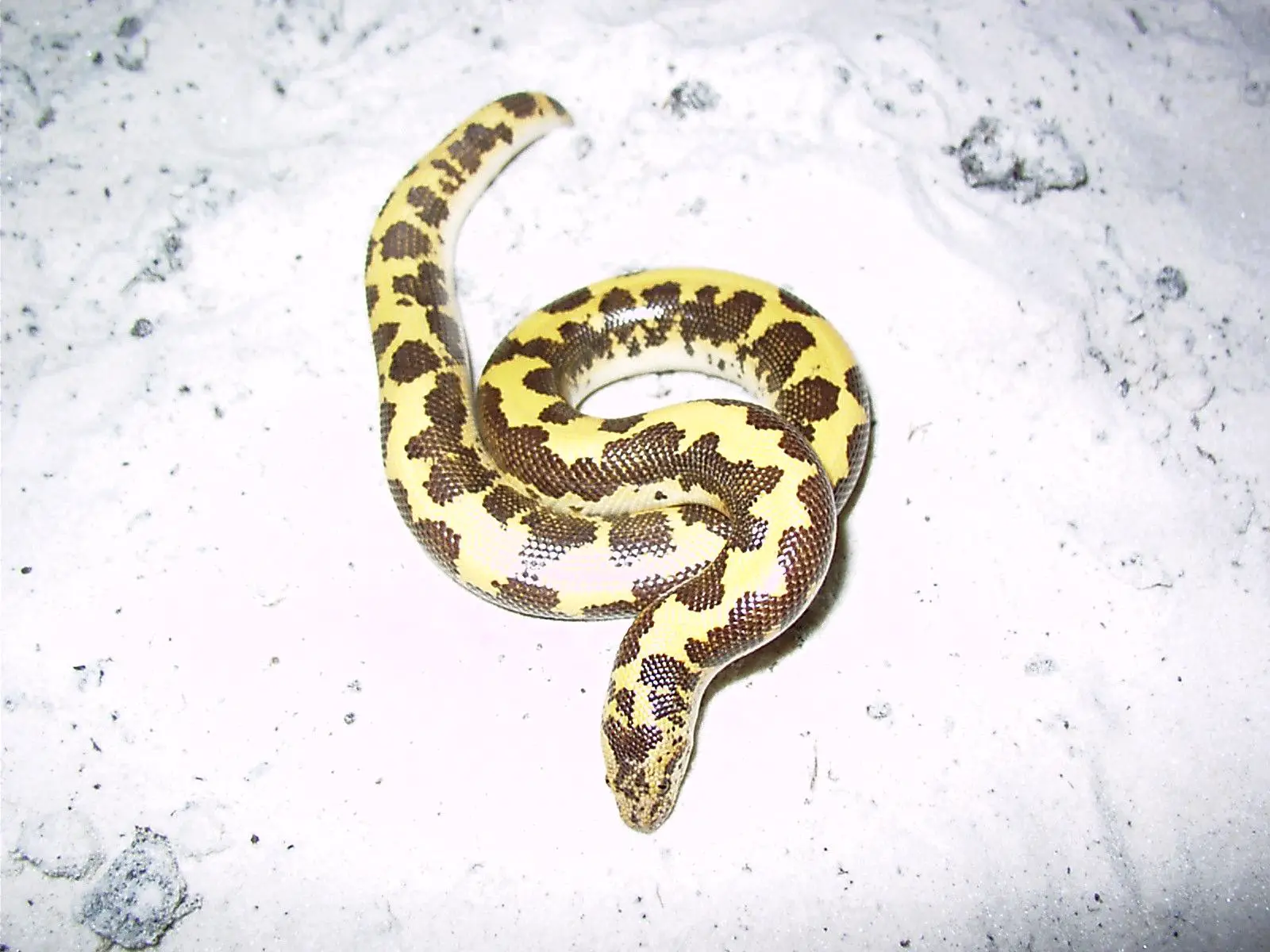
Image credits: wikipedia
A vivarium with a lockable lid is necessary because this is a snake. If you are using a screen cover for your Kenyan Sand Boa, place a heating pad below one side of the enclosure and turn it on continually, seven days a week.
Moreover, give your snake access to an incandescent lamp that heats its enclosure during the day.
The habitat’s colder side may only be 80F, while the hot area should be 95F. Aim for 75°F in the evening. Keep the environment as straightforward as possible because this snake prefers to burrow. Utilize only large rocks that you can secure to the side of the habitat. Your Kenyan Sand Boa could be killed if it decides to hide behind the rocks because the stones could fall on top of it.
Another argument against limiting decor is that snakes have a reputation for being quite destructive. Sand will be your substrate, but you may also use newspaper, coconut mulch, or aspen bedding. Gravel and cedar shavings should not be used.
Your Kenyan Sand Boa will like mice, especially young, living pinky mice.
Mice may be frozen or thawed as they become older. You may feed them by using tweezers or tongs that are specially meant for feeding your snake.
Madagascar day gecko
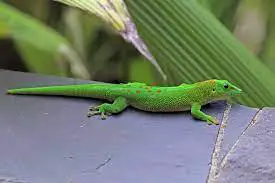
Image credits: wikipedia
These massive day geckos, as they are also known, maybe as long as 10 inches. They flourish in arboreal vivariums, where the ideal relative humidity is from 55 to 65%.
They enjoy being outside when it’s between 80 and 88 degrees Fahrenheit, and they love to sunbathe when it’s about 91 degrees. In the evening, the temperature should drop to the low 70s.
To fully appreciate the colors of these creatures, the right lighting is required. Look for lights that have a CRI of 85 or above, produce UVB, and have heat.
Make sure the tank has enough climbing opportunities for your day gecko. Large pieces of bark or bamboo may be utilized for this. You should let your gecko travel freely both inside and outside of the bamboo, regardless of which one you pick.
Start the substrate with a.75″ layer of clean, reptile-grade pebbles, then add an inch of reptile bark mixed with organic potting soil to create the ideal base for your gecko.
For the Madagascar Day gecko, bromeliads, orchids, and sansevierias are the finest plants. They may be interred beneath the earth. Orchids may be planted along the cage’s edges.
To provide the gecko with water, spray it twice daily with filtered or reverse-osmosis water. Always handle your gecko gently since it may easily lose its skin and catch visitors off guard.
Rosy boa
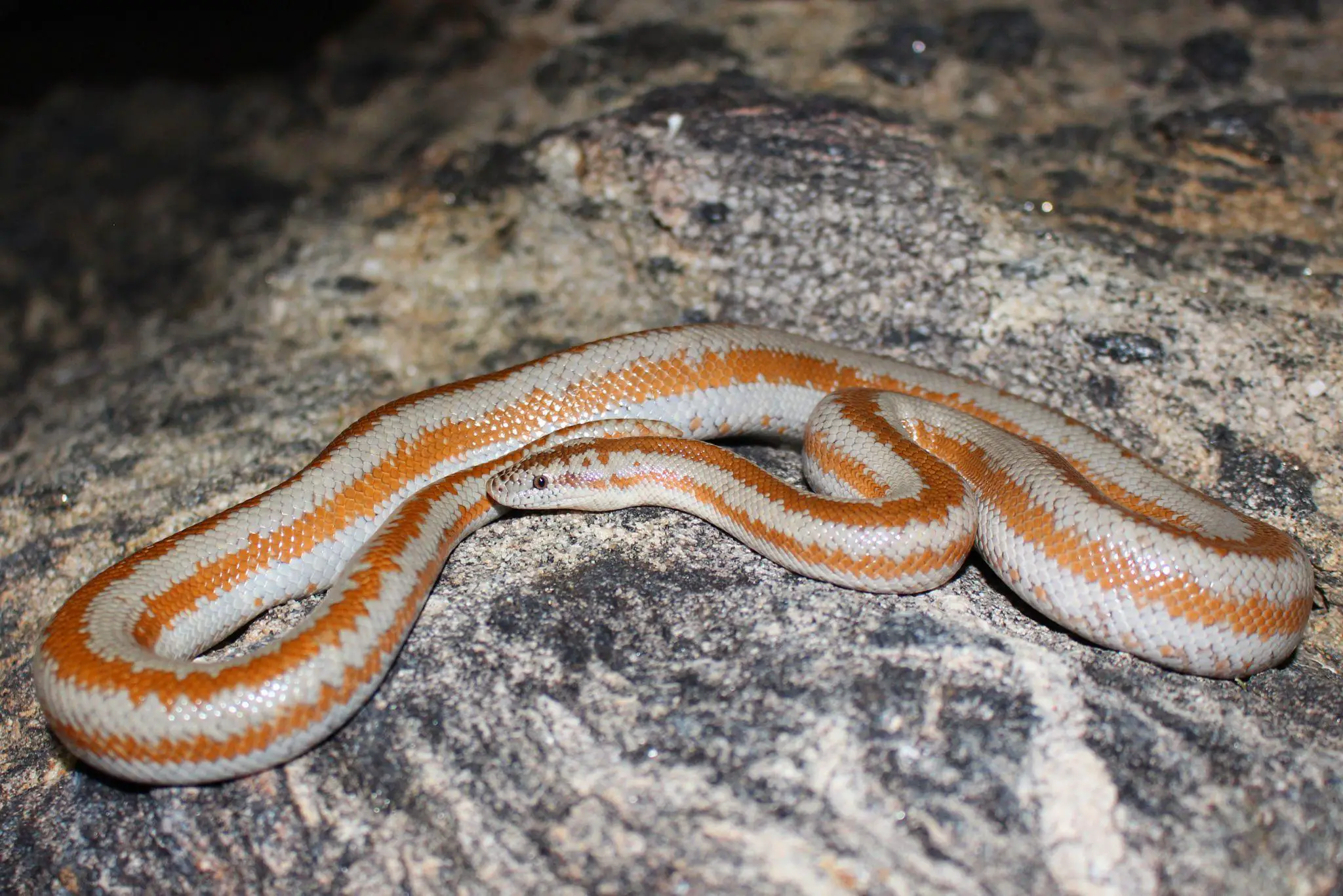
Image credits: wikipedia
Rosy boa is another snake option for your 10-gallon-long tanks. rose boas are excellent escape artists, you must make sure the tank cover is securely fastened. Although these snakes are easy to find and ideal for beginners in reptile keeping, keepers must be careful to prevent any potential escape routes for their boa.
Screening is not the ideal solution due to the screen’s ability to hurt your snake. If you MUST use a screen, use screen clips like these to hold it in place.
Use aspen shavings or paper towels as your substrate. Heat tape or a heating pad can be used to create a temperature gradient. keep the temperature between 80 and 85 °F.
Rosy boas search for a secure location to live. One can be purchased from a nearby pet store or built out of cardboard.
Once it feels secure, the snake will cease pressing its snout on the cage. Place your hides in both chilly and warm areas to accommodate your reptile.
Your main lighting goal should be to create a heat gradient that helps your snake to go to its preferred location.
Use hot tape on one side of your habitat to do this. Use a thermostat, more especially a pulse-proportional thermostat, to maintain the right temperature for your rose boa.
pygmy chameleons
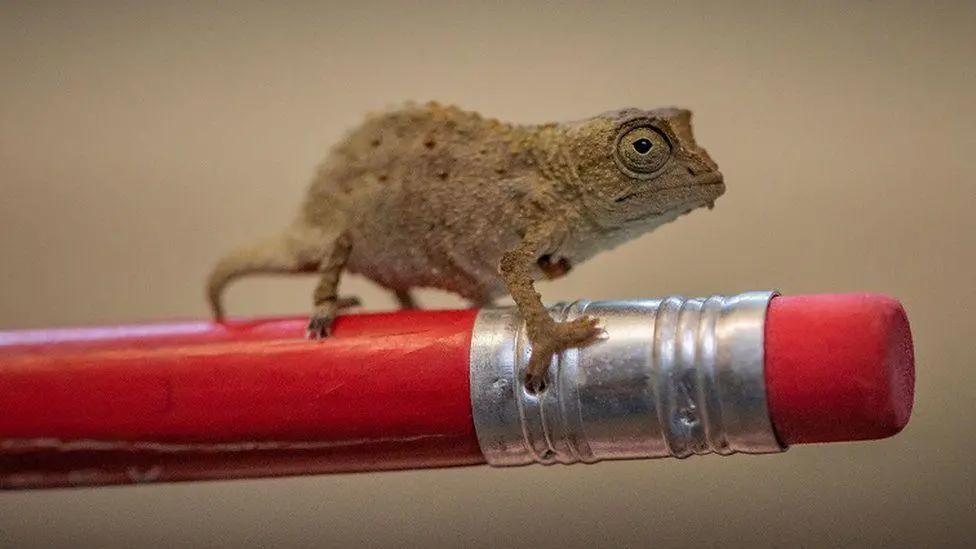
Image credits: BBC
One of the nicest things about pygmy chameleons is how little maintenance they need. They can even survive in a five-gallon tank if necessary and a 10-gallon-long tank is more than enough for them. These non-climbing reptiles require space to move horizontally.
It takes only a short time to set up the habitat. These are friendly creatures that prefer to reside on the forest floor and thrive in an area that is densely vegetated, whether the plants are real or synthetic. Your chameleons can hide and feel comfortable because of this.
Before putting any plants, genuine or artificial, into the habitat, make sure they have been cleaned thoroughly. Pesticides are a problem with real plants; hazardous bacteria can grow on fake plants. Coconut bedding can be used to fill the substrate to a depth of 2-4 inches. To aid the plants’ ability to drain, you should also add a layer of stones beneath the bedding. The pygmy chameleon has places to climb up on little sticks and branches.
These adaptable organisms like a temperature range of between 70 and 80 degrees Fahrenheit. A temperature gradient or UVB lamps are not necessary for pygmy chameleons.
They do, after all, inhabit a natural setting on the understory of the forest, where the light doesn’t shine as strongly. Turn the lights on and off continuously for 12 hours. The temperature may be set to 80°F during the day and 75°F at night.
Maintain the habitat’s humidity between 60 and 80% and sprinkle it twice daily for best results.
Anole
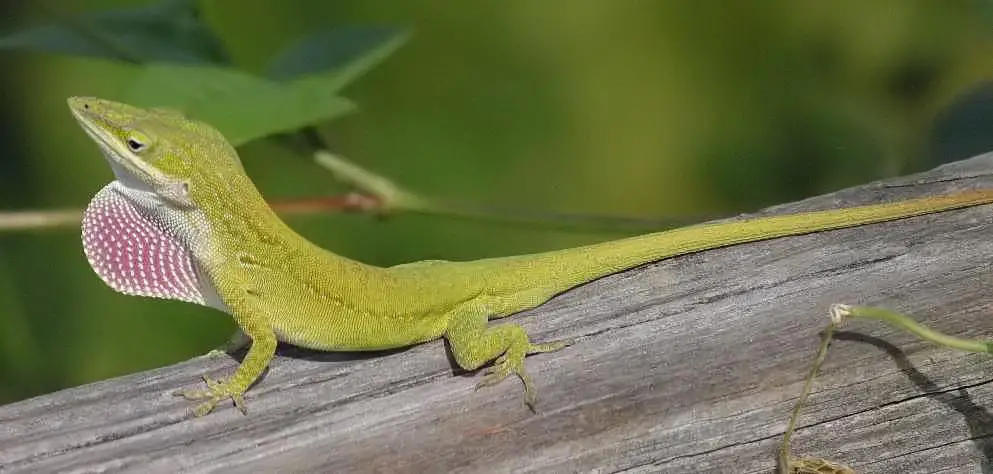
Image credits: wikipedia
In a tank with a capacity of 10 gallons, one anole can fit comfortably. Ensure your habitat has a screen lid since these little critters like to climb. A great substitute is a tank with sides that are at least 18 inches high.
For your anole’s bedding, you can use moss or coconut fiber; aim for a depth of around 3 inches. The humidity may be increased by adding more moss. Choose what you can afford because you will need to modify this once every month. Anoles need to hide, therefore give them places to do so by utilizing objects like wood, stones, coconut shells, or pots. Provide branches and live plants for climbing to keep your anole occupied.
The thermometers that are located at the top and bottom of the habitat may be used to measure temperature. To warm it, you might use a ceramic heating element or light. Check the humidity with a hygrometer; it should be between 60 and 80%.
Water bowls should constantly be kept full, and the habitat should be sprayed at least twice every day. Both moss and coconut fiber are excellent at holding moisture. Since anoles are diurnal, 12-hour day and night cycles must be created using UVA/UVB lighting.
Crested gecko
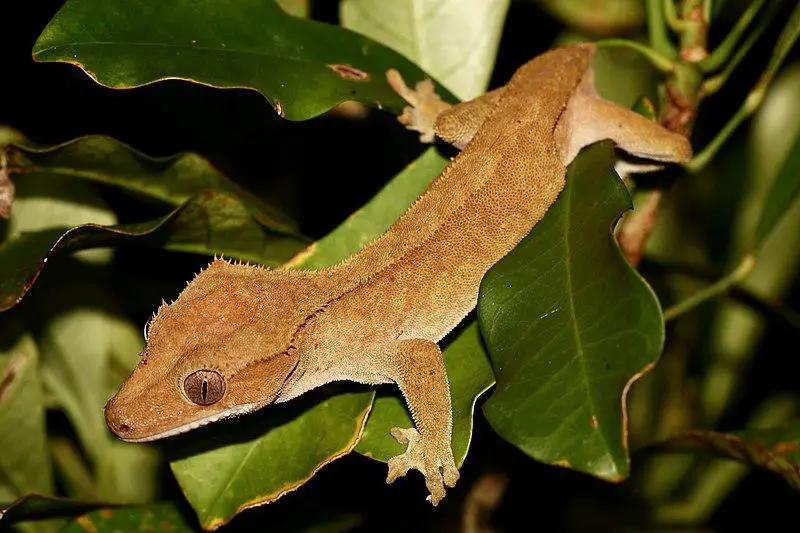
Image credits wikipedia
We want to emphasize once more how important it is to give your crested gecko a safe refuge, and the taller the walls may be, the better. After all, these men are climbers.
For your crested gecko, you must provide a lot of branches and hiding places. Both actual plants and artificial ones are acceptable. Make sure the humidity maintains between 60 and 80% by measuring it with a hygrometer. By sprinkling the habitat twice daily, you may maintain a certain amount of humidity.
Substrates include things like coconut fiber, bark, and sphagnum moss. Maintain overnight temperatures of 68 to 75F and daytime temperatures of 75 to 82F. A low-watt heat bulb is ideal for this; radiant heat is also suitable.
Your crested gecko needs constant access to light. If you don’t have a ceramic heater or incandescent night light, use an incandescent day bulb for your gecko’s bathing area. Because of their nocturnal nature, it is typical to discover these creatures in their hiding locations all day long. They frequently jump from branch to branch, so be on the lookout for this.
Since stressful events may lead them to lose their permanent tails, owners should take extra care with their geckos. To maintain moisture in their eyelids, crested geckos often lick them. Aim for temperatures between 80 and 90 F on the warmer side. Ideal humidity ranges from 10% to 30%. Only a low-watt UVA/UVB light is needed by Leos for their whole 12-hour daily cycle.
A reptile carpet or a semi-arid bioactive substrate are other good choices for a substrate. Use reptile carpet only if it is 6 inches or shorter to reduce the chance that your Leo may eat substrate.
Make sure that the leopard gecko’s tank has skin lining on both sides. They prefer climbing on low branches and rocks because they have locations to do so. Give them big shallow pans of water for soaking to keep them hydrated. This dish has to be cleaned and replenished each day.
African house snakes
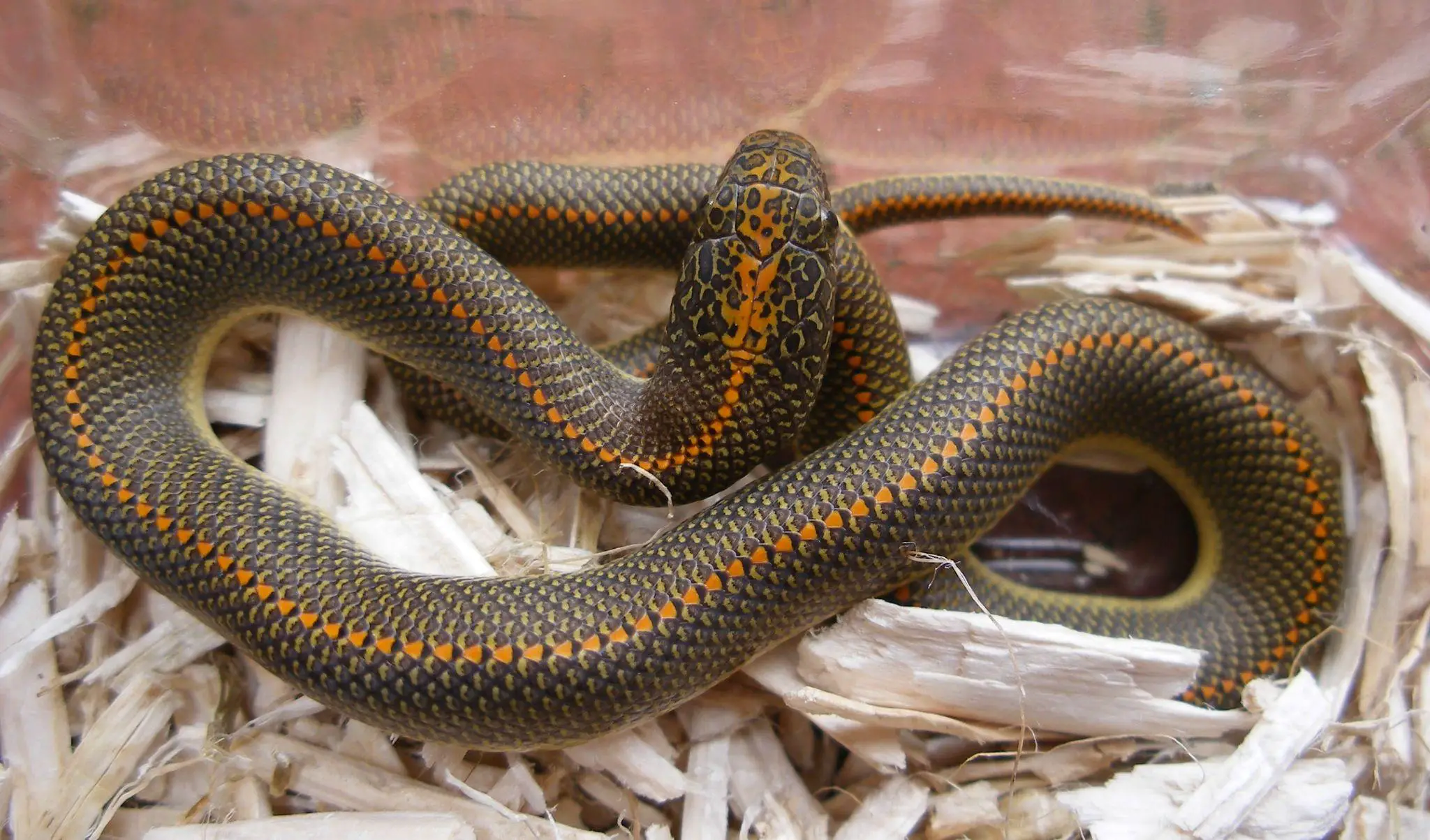
Image credits: wikipedia
With these snakes, you can use a 10-gallon-long tank, first start with a substrate of aspen or beech chips. Layer them thick enough that your snake can dig comfortably into the substrate. You may also use paper towels or newspapers.
To ensure that your snake behaves properly and climbs as it is accustomed to doing, provide it with a variety of plants and branches to perch on. Fake ones are OK for this usage. These should be introduced to the habitat’s warm and chilly sides.
You may use a ceramic lamp or heating pads to warm up one side of the tank. Keep this section of the tank at 90°F and the warm side at about 70–80°F.
Use thermometers to verify that these temperatures are consistent. The African house snake can live without UVB light, however, it is still OK to use it.
Ensure that the humidity stays between 30% and 50%.
If you spritz the tank once per day or put a bowl of water inside, the habitat will always be adequately humid. To maintain the ideal degree of humidity, make sure that this is kept on the colder side of the cage at all times. One thing to keep in mind is that African house snakes love the water because it helps their molt. To keep your snake healthy while it is in the water bowl, make sure you replace the water frequently.
Green snakes
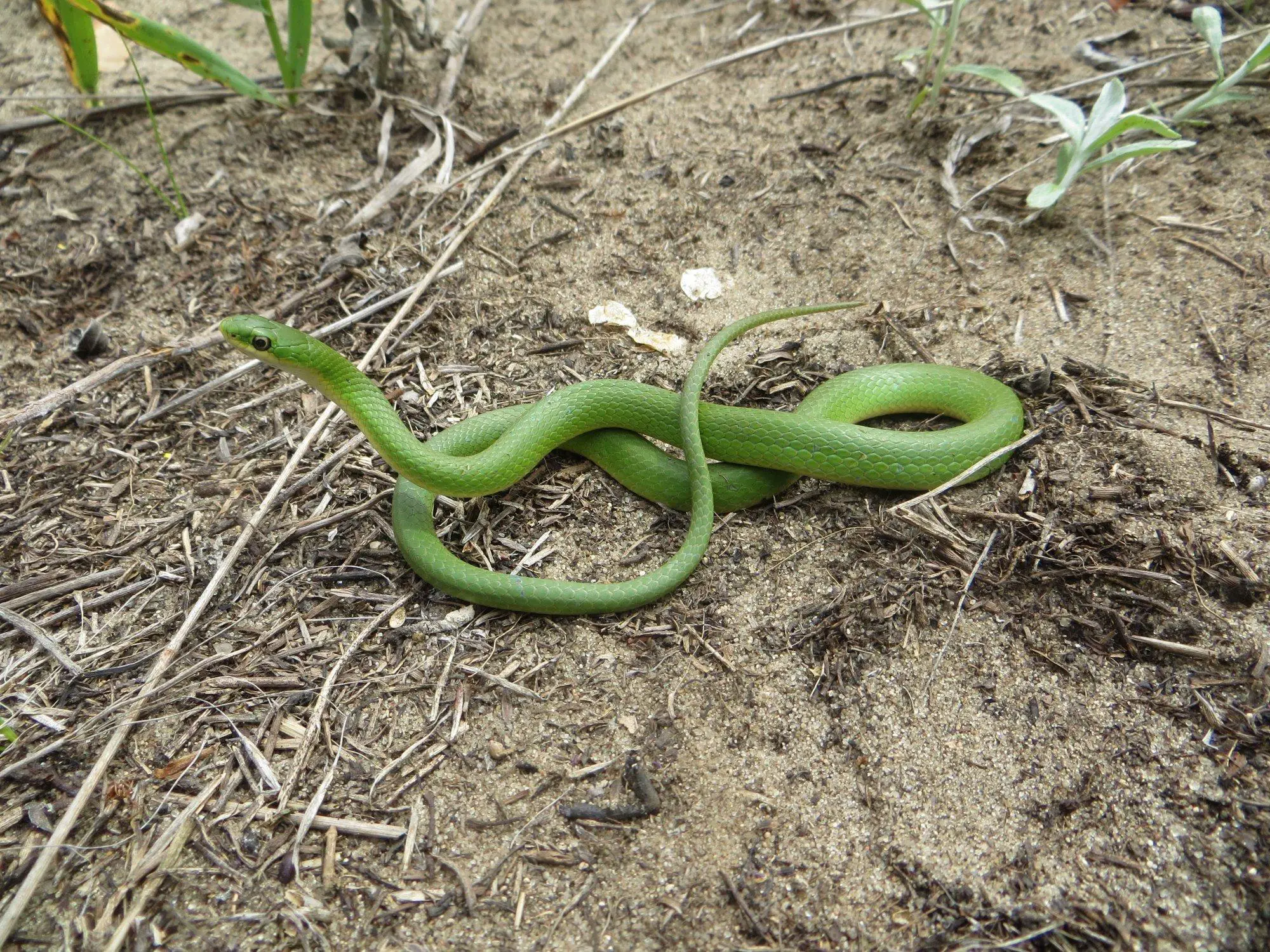
Image credits Wikipedia
The rough and smooth green snake can survive in a 10-gallon tank if you can provide it with some restricted vertical climbing spaces. If not, put off getting this one as a pet for the time being.
Because handling this snake requires considerable snake-handling skills, it is not recommended for beginners. Because it is a cautious species, peaceful locations are its ideal environment. Despite this, some people pick it as a pet due to its exceptional attractiveness.
As they are insectivores, green snakes mostly eat insects. They eat spiders, crickets, moths, caterpillars, spiders, and worms in the wild. Their dinner shouldn’t be larger than the thickest parts of their body.
Although these arboreal snakes normally drink from leaves in the natural, their cages must be misted every day to enable them to do so. A source of standing water is rarely visited by them. Use moss as a substrate if you want to retain moisture.
How to make your 10-gallon-long tank habitable?
You can’t just pick up a great reptile setup at the store. You must be ready to invest a large amount of time in preparation before making any purchases. In light of this, let’s talk about the characteristics of an excellent reptile setup.
Prepare yourself
Ensure sure the vivarium is set up before taking your pet home. Be sure to thoroughly examine and investigate the requirements of your specific reptile before putting together all of the necessary equipment. Before bringing your pet home, provide the atmosphere that it requires and make sure it is prepared.
If you set it up ahead of time, maybe a week before you are anticipated to pick up your reptile, it will have time to settle down and you can ensure that all of the lamps, thermometers, and other equipment are in working order.
In the end, it will make the difficult move from the pet store or breeder to your home simpler and less stressful.
Choose the right material for your tank
For the habitat, you may use a standard 10-gallon aquarium tank. The glass model is preferable to the plastic one. Glass has fewer hazardous compounds and is more durable than plastic.
Glass can withstand the heat and humidity found in a reptile’s habitat better than other materials. And if you can, keep reaching for more. For instance, go for a 15 or 20-gallon tank if you can afford it because bigger is always preferable.
Good substrate
Ask the employees at the pet store or the breeder which substrate is best for your pet. Making the wrong decision might cause your pet serious illness or even make tank cleaning challenging.
Peat moss, reptile carpet, or even newspaper may work depending on the species of reptile, so be careful to consult a specialist.
Make it warm
Many reptiles are arboreal, meaning they prefer to remain in trees or other above-ground structures, as they are more comfortable there.
Make sure there are lots of objects in the 10-gallon tank for them to climb on. Also, they will need access to a drink and a cool hiding area. It is necessary to give both digestive heat and ambient heat.
Usually, ambient heat is produced by an overhead light or a ceramic heat element put into a light socket. Make sure the reptile cannot contact your pet despite the possibility of both of these burning them.
Never deny your pet access to a cozy hiding place.
Your vivarium only needs digestive heat in a small fraction of the area; the rest might use ambient heat.
UVB
You must use the aquarium’s lighting to create day and night cycles. It will promote healthy digestion and your pet’s long-term welfare. You should utilize full-spectrum fluorescent lighting and incandescent lights for sunbathing and ambient heat in your 10-gallon-long tank.
You may give your vivarium the needed UV lighting by using a full-spectrum bulb. This will make it easier for your reptile to manufacture vitamin D3, which it needs to digest calcium.
Lid for the 10-gallon long tanks
Lids are necessary for a vivarium, particularly if you have snakes that regularly escape.
You should confirm that your lid can serve as a barrier between the animal and the heating/lighting system. Most people do this when staring at a screen. Glass covers shouldn’t be used since they reflect heat and block UV rays from the lighting system.
It guarantees that the cords connecting the heating device cannot be eaten or chewed by reptile claws or teeth while also providing a tiny hole for them to leave the tank.
Conclusion
For a variety of reasons, including the possibility that some of them may be content without a huge confinement, reptiles can make excellent pets. If you’re searching for a pet that won’t take up much room in your house, any of the reptiles on this list would be a perfect choice.
Nonetheless, some of these creatures could outgrow a ten-gallon tank in the course of their existence. Consider an update if you see that your pet is dissatisfied with its confinement.
FAQs
Can a snake fit in a 10-gallon-long tank?
The majority of snake experts will advise against using a 10-gallon arrangement for adults. Selecting a snake for your setup needs to be a wise decision because it is frequently utilized for youngsters or to keep prey items alive.
Can a leopard gecko survive indefinitely in a 10-gallon-long tank?
In 5 to 10-gallon-long tanks, most adult leopard geckos find it difficult to roam around and shed their skin as freely as they would like. As a result, the only fish often kept in these aquariums are young geckos. Even after that, you’ll still need to change up these tanks in a few months because leopard geckos grow quickly.
Can a turtle survive in a 10-gallon-long tank?
Let’s get right to the point: a turtle cannot live in an aquarium that is less than 10 gallons in size. The smallest tank size appropriate for a tiny species, such as a mud or musk turtle, or a hatchling, is a 40-gallon setup. For your pet turtle, a larger tank is often preferable.







